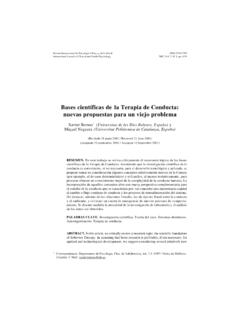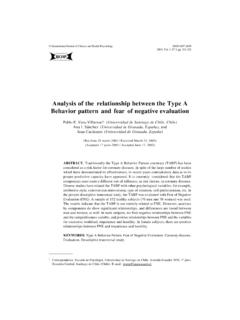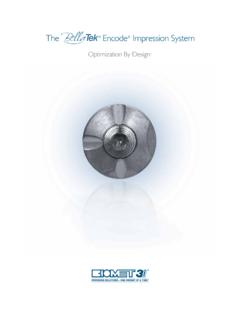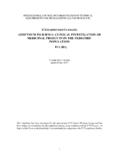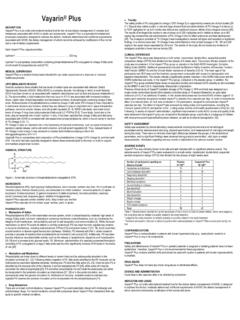Transcription of Sixth version of the Addiction Severity Index: …
1 Sixth version of the Addiction Severity Index: Assessing sensitivity to therapeutic change andretention predictors1 Mar a Jos Casares-L pez2 (Universidad de Oviedo, Spain),Eva D az-Mesa (Universidad de Oviedo, Spain, Spain),Paz Garc a-Portilla (Universidad de Oviedo, Spain, Spain),Pilar S iz (Universidad de Oviedo, Spain, Spain),Mar a Teresa Bobes-Bascar n (Hospital Cl nico de Valencia, Spain),Eduardo Fonseca-Pedrero (Universidad de La Rioja, Spain),Eduardo Carre o (Universidad de Oviedo, Spain, Spain),Pedro Marina (Universidad de Oviedo, Spain, Spain),Mar a Teresa Bascar n (Universidad de Oviedo, Spain, Spain)
2 ,John Cacciola (University of Pennsylvania, USA),Arthur Alterman (University of Pennsylvania, USA), andJulio Bobes (Universidad de Oviedo, Spain, Spain)ABSTRACT. The main purpose of this multicenter ex post facto prospective studyis to examine the psychometric properties of the Addiction Severity index version (ASI-6) in Spanish outpatients and determine the predictor variables of treatmentadherence. A total of 186 outpatients with a substance dependence diagnosis (mean age40 years; 80% male) were assessed with the ASI-6 and Clinical Global Impression1 This research was supported by the Spanish Plan Nacional Sobre Drogas.
3 The authors want to thankthe institutional support and the professional participation of eight centers: UTCA, SERGAS,Orense, C. Asturias, Gij n, H. Ram n y Cajal, Madrid, H. Sant Pau, Barcelona, UAD, Carballo (LaCoru a), CAD San Juan de Dios, Palencia, CSM Retiro, Madrid, and CSM Teatinos, Oviedo. Finally,we would especially like to thank the TRC (Treatment Research Center) and TRI (TreatmentResearch Institute) at the University of Correspondence: Facultad de Psicolog a. Universidad de Oviedo. Plaza Feijoo, s/n. 33033 Oviedo(Spain). E-mail: International Journal of Clinical and Health PsychologyISSN 1697-2600 printISSN 2174-0852 online2011, Vol.
4 11, N 3, pp. 495-508 Int J Clin Health Psychol, Vol. 11. N 3496 CASARES-L PEZ et al. Sixth version of the Addiction Severity index (CGI). Results revealed a moderate decrease in ASI-6 recent summary scores (RSSs)in the Alcohol (t = ; p < .001), Drug (t = ; p = .035), Psychiatric Status(t = ; p < .001) and Family/Social Relationships areas (t = ; p < .001) frombaseline to six months. The adjusted odds ratio (OR) related to an increased probabilityof adherence was for the CGI-S score (95% CI ). On the contrary, loweradherence was predicted by Severity in the Drug Scale with an OR of.
5 95 (95% ). The Spanish ASI-6 appears to be a valid instrument that is sensitive totherapeutic change, providing relevant and reliable information not only about severityof Addiction but also about substance abuse treatment adherence Addiction Severity index . Sensitivity to change. Retention. Prospectiveex post facto El principal objetivo de este estudio multic ntrico expostfacto, prospectivode seis meses de duraci n, fue analizar las propiedades psicom tricas de la sexta versi ndel ndice de Severidad de la Adicci n (ASI-6) en pacientes ambulatorios espa oles ydeterminar variables predictoras de la adherencia al tratamiento.
6 Contamos con 186pacientes ambulatorios con diagn stico de dependencia de sustancias, con edad mediade 40 a os, 80% varones, evaluados mediante el ASI-6 e Impresi n Cl nica Global. Seobserva una disminuci n moderada de las Puntuaciones Observadas Estandarizadas POEs- en el rea Alcohol (t = , p < .001), Drogas (t = , p = .035), EstadoPsiqui trico (t = ; p < .001) y rea Familiar (t = , p < .001) en los seis mesesde tratamiento. La impresi n cl nica de gravedad es la variable que mejor predice laadherencia al tratamiento [OR= (IC del 95%, )]. Por el contrario, elriesgo de abandono fue predicho por la mayor gravedad en la POE del rea Drogas[OR=.]
7 95 (IC 95%, .92 - .98)]. La versi n espa ola del ASI-6 puede ser un instrumentov lido y sensible al cambio terap utico, que proporciona informaci n relevante tantosobre la gravedad como sobre la predicci n de la adherencia al CLAVE. ndice de gravedad de la adicci n. Sensibilidad al cambio. Reten-ci n. Estudio prospectivo ex post instruments should possess accurate and refined psychometric propertiesin order to evaluate and estimate the efficacy of interventions. Therefore, it is of greatimportance for an assessment questionnaire to prove both fair sensitivity to change andpredictive power of treatment adherence in order to monitor patient progress and yieldan optimum intervention algorithm for each client.
8 This need to assess the effectivenessand generate new evidence was recently promoted at the World Health OrganizationHelsinki Ministerial Conference on Mental Health (World Health Organization, 2005).Since 1979, the Addiction Severity index ASI- (McLellan, Alterman, Cacciola,Metzger, and O Brien, 1992; McLellan, Luborsky, Woody, and O Brien, 1980) has becomeone of the most relevant instruments for substance use disorders in both clinical andresearch settings; in all its versions and in different contexts: prisons, outpatient,residential or substitutive methadone therapy (Alterman, Cacciola, Dugosh, Ivey, andInt J Clin Health Psychol, Vol.)
9 11. N 3 CASARES-L PEZ et al. Sixth version of the Addiction Severity Index497 Coviello, 2010; Cacciola, Alterman, McLellan, Lin, and Lynch, 2007; Cacciola, Dugosh,and Camilleri, 2009; Casares-L pez et al., 2010; McLellan, Cacciola, Alterman, Rikoon,and Carise, 2006). This structured interview was designed to provide basic informationon various areas of patients lives and to monitor clinical changes and treatmentoutcomes. Specifically, ASI-6 focuses on patient functioning in seven problem areascommonly involved in substance use disorders (SUDs), including medical status,employment, drug and alcohol use, illegal activity, family/social relationships (problemswith children, family/social support and problems), and psychiatric status.
10 The sixthversion of the ASI was recently adapted into Spanish, and although it has demonstratedacceptable psychometric properties for use in clinical practice and it has sensitivity tochange over time, in other words, the degree to which it reflects client variations thatoccur due to therapy has yet to be explored (D az-Mesa et al., 2010). Concomitantly,duration of treatment adherence is one of the most important predictors of successfuloutcomes in rehabilitation programs (Hill and Lambert, 2004). However, dropout rates areexponential, ranging between 60 and 80% of patients in residential and outpatientsettings (Guy, 1976; Hill and Lambert, 2004).
